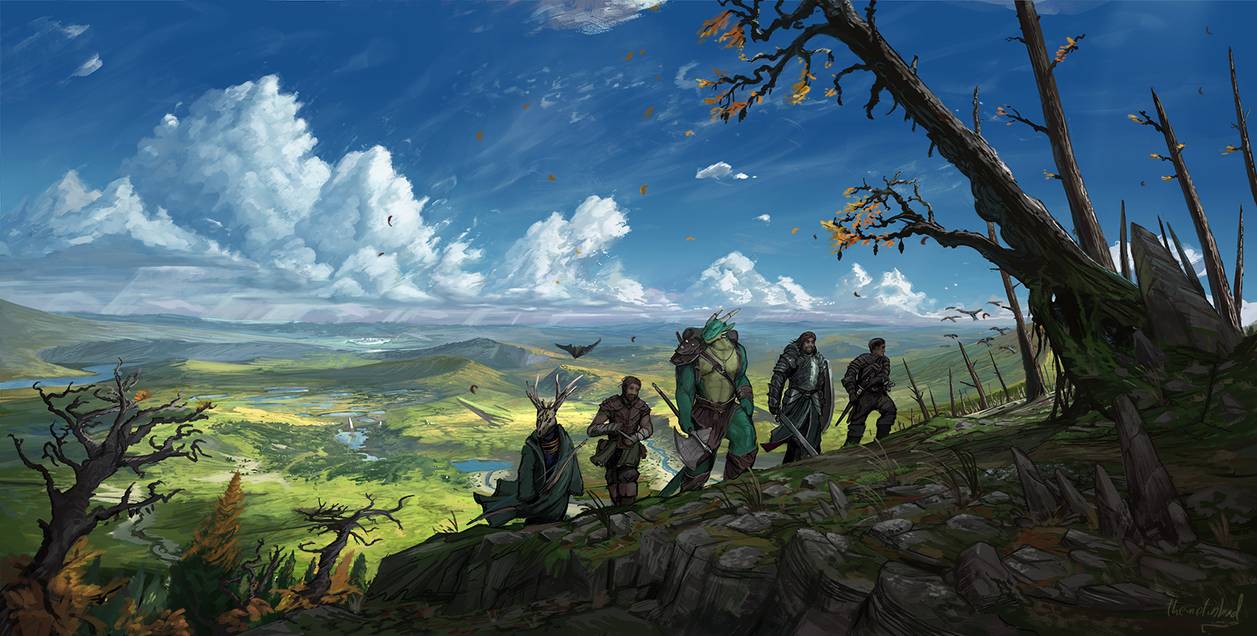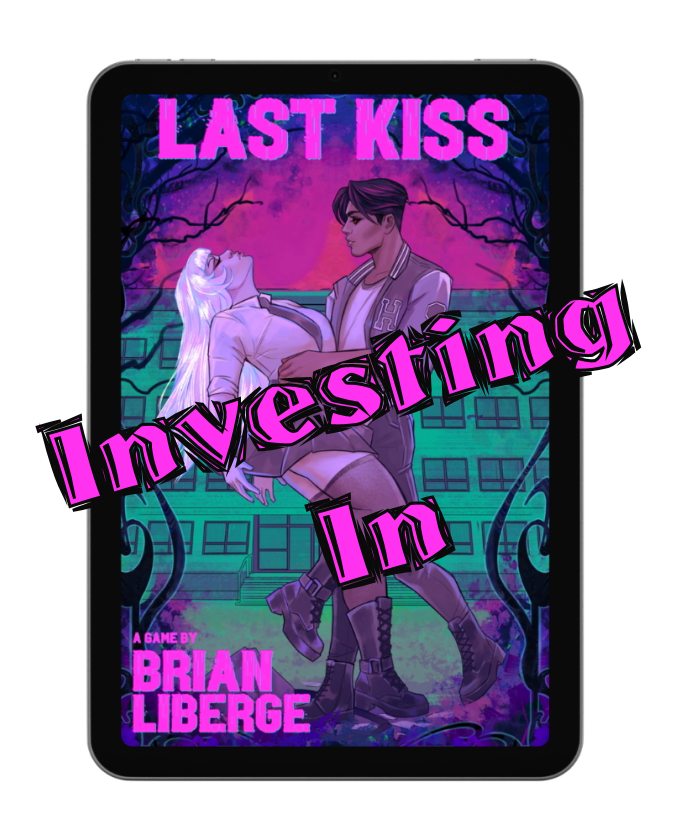One of the things that has greatly excited me about the release of Pathfinder 2E has been the dedication to the Age of Lost Omens, the world of Golarion, and to the people in it. Paizo’s team and partners have focused on growing their campaign setting and using it to craft the story they share with all of us and that we get to help grow along with them! Know that if you’re reading this and you’re considering whether 2E is right for you that it’s not a system built around a specific world. You wouldn’t have to play in Golarion; indeed perhaps in time there will be campaigns found on the other planets of its cosmos… But instead the main campaign world is a complex, living thing, well supported by the ruleset as well as the contributions of numerous developers and artists.
Learn and Adventure
I love the Iconics used throughout Pathfinder’s first edition and now continued into the second. At the beginning of the Core Rulebook’s first chapter we find Valeros, Kyra, and Merisiel facing the undead in a short piece of fiction. Later chapters provide rich full page pieces of art showing other Iconics in their adventures. Not only do I enjoy a feast for the eyes but I like seeing the story in them. Amir, Harsk, and gleeful Fumbus go shopping for equipment as we review what weapons and armor are available in Chapter 6. We learn and adventure along with the Iconics in a way that is endearing. They are a joy to see in comics too. I’m a particular fan of Hollow Mountain and the reluctant cooperation between two adventuring parties, as well as Seltyiel’s interaction with an incubus…
It’s not simply the Iconics though. In the same Core Rulebook we have Chapter 8 reminding us why it’s the Age of Lost Omens. Honestly, it was the first chapter I read! The various regions of the Inner Sea are teased with reminders of the past and those lands futures. The art is inspiring, evoking imaginary scenes that stir the creative in me as while I love adventure paths (I’m GMing Strange Aeons right now) I also enjoy creating campaigns within existing worlds. Seeing adventure paths’ outcomes reflected in 2E makes this all the more exciting for those groups who’ve played through them. I was also pleased to see the cultural groups and ancestries highlighted with art. The factions remind us what organizations are moving and shaping the future in the age; it’s not only the Pathfinder Society after all! Religious details are ever important to these cultures, especially when miracles of healing or the power of undeath holds influence in your community. I wanted more!
The World of Golarion
Seeing those details I dove quickly into my World Guide, actually finishing it before I cracked open the Bestiary. We get a bit of the different continents as well as the underground Darklands. I appreciate the overview of the cosmology and look forward to greater detail in a future release; there’s always that wizard who wants to take their friends planes-hopping. Every region gets fantastic detail, highlighting the beginning with art, a map, and a key as to the nature of the people, trade, and religion. I love the timelines along the sides with various major events called out, including the events of some of your favorite adventure paths! When a campaign world changes around your players’ characters, governments and creatures responding to their actions, even while other events occur for good or ill, then the world feels alive. It’s not an easy feeling to evoke but the World Guide puts the tools in your hands to make it easy!
Weaving these details into games will only make them and the world around your players more colorful, more alive, and more real! Paizo’s fiction novels as well have told numerous stories that grow the experience; my friend Rich references them often and he’s brought details from them into our games. Some correspond with the Lost Omens’ releases. There’s notes of cities and NPCs that are or may be featured in other materials too. I want to see what’s next for Alkenstar or learn the details of the “Thrice-born Queen” Aethusa! This reminds me I need to get another World Guide poster map! It’s a beauty!
The People of Golarion
Perhaps what might truly inspire your players is the Character Guide. I mentioned on some of Paizo’s social media that one of my players scooped up the book the minute I had it on the coffee table. He’d seen Mark Seifter and Payton Smith discussing it on a Pathfinder Friday broadcast so I already knew he was excited at the opportunities ahead. You can see Perram’s review here as well. This friend (also a Rob) said he wanted to try playing everything and while the sheer amount of games you’d need to do so would probably take us into retirement, it goes to show the success of the character option crunch but the vibrant flavor of those details. The abilities hinted at in legend or that allies or enemies use have defined rules so you can be them too, just like in what you’re reading and just like in the art you see.
I love the options for existing ancestries like regional feats and the new ancestries as well. A Fungus Leshy is definitely in my future! The factions and the character options there easily provide a player for what they want to build toward or how they want to see their character grow within this constantly evolving world. This is shared storytelling at its finest, again because there’s something greater than yourself or even what you’ve outlined in an adventure shaping the world and its story. It certainly doesn’t hurt that the art again is beautiful! The Hellnknights or the Magaambya dancing above1 jumped out at me. I highly suggest reading Tim Pratt’s When It Rains when you have a chance. The Tales of Lost Omens have been another fine piece of world building that hopefully inspire you and your adventures!
What If We’re Not On Golarion?
Now again I’ll say that as much as I love the world of Golarion, its detailed timeline (which is reflected in the World Guide), and its diverse people there is still great value in the rules provided. Maybe your knights aren’t tied to Hellish ideals of law but you can still tweak the flavor of their abilities as you utilize the feats in that section of the Character Guide. Instead Inevitables may frequent a region of your campaign and the order seeks to emulate, perhaps even works with some of them. The World Guide details feats for the Red Mantis Assassins organization, but perhaps your assassins favor quick death absent of Achaekek’s religious overtones. Flavor components like red mist can become shadow, prayers to the mantis god can become an affirmation to help those who’ve whispered to those shadows, and the like.
You might also take from reading the guides to find details of adventures you’ve not run. I know I have for that Strange Aeons game I mentioned, especially details within the Eye of Dread or Shining Kingdoms section. Hints of details to call out in the world, perhaps when that charming PC in your party is out gathering information, will again add to the living world feeling. It’s why the Pathfinder Society’s organized play also adds to the dimension of events and people moving around and outside only the actions of your players. The world will feel their impact, especially at high levels, but it will keep moving too.
Investing In:
What a wonderful world you share with your players and your GMs will reward everyone participating! I’d encourage you to read the details of Golarion and its rich lands and varied cultures if only for inspiration but I’ve a feeling you’ll become enamored as well. The Core Rulebook gives a taste to the Age of Lost Omens for all to read, hinting at adventures ahead. The World Guide details regions impacted by war, economic development, and magical calamity. Nations rise and fall while the people struggle to survive. Those people are diverse and well-represented in the Character Guide. And throughout all you’ll find what you need to put your players in that world and provide ways for the story to move along with them!
Sources
Banner – Creative Commons credit: The winding path by ThemeFinland
- When It Rains, illustration by Tomasz Chistowski







